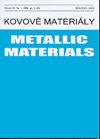铁镍及镍基高温合金的蠕变行为及显微组织表征
IF 0.7
4区 材料科学
Q4 MATERIALS SCIENCE, MULTIDISCIPLINARY
引用次数: 0
摘要
新的高温合金不断被开发,以满足对高抗蠕变和低制造成本合金日益增长的需求。本研究对两种合金进行了比较蠕变试验和微观结构表征。本文将Fe-Ni- cr和NIMONIC 80A命名为一种低成本、Ni和Fe含量适中的铁镍高温合金。蠕变实验在650至750°C的温度范围和500至600 MPa的载荷范围内进行。显微结构表征和表面分析进行了显微镜技术,如光学,扫描电子能谱和透射电镜。相定量鉴定采用Rietveld细化。与NIMONIC 80A相比,Fe-Ni-Cr高温合金具有更高的抗蠕变性能。Fe-Ni-Cr合金具有较高的碳、铁含量和铌的加入,形成了富铁、富铌的γ (cid:3)金属间化合物和碳化物。这些碳化物和金属间化合物作为位错滑动和爬升的障碍,降低了蠕变速率。与Fe-Ni-Cr相比,NIMONIC 80A中还原性碳化物促进了变形过程中晶粒间的相对滑移,有利于蠕变速率加速和早期破坏。本文章由计算机程序翻译,如有差异,请以英文原文为准。
Creep behavior and microstructural characterization of iron-nickel and nickel-based superalloys
New superalloys are constantly being developed to fulfill the increased demand for alloys with high creep resistance and low manufacturing costs. This study subjected two alloys to comparative creep tests and microstructural characterization. A novel low-cost iron-nickel superalloy with intermediate Ni and Fe content was designated in this work as Fe-Ni-Cr and the NIMONIC 80A with a high Ni. Creep experiments were carried out at temperatures ranging from 650 to 750 ◦ C and loads ranging from 500 to 600 MPa. Microstructural characterization and surface analysis were carried out using microscopy techniques such as optical, SEM with EDS, and TEM. For phase quantitative identification, Rietveld refinement was utilized. Compared to NIMONIC 80A, the new Fe-Ni-Cr superalloy showed higher creep resistance. The Fe-Ni-Cr alloy has higher percentages of carbon and iron and the addition of niobium, resulting in the formation of γ (cid:3) intermetallics and carbides rich in iron and niobium. These carbides and intermetallics operate as obstacles to dislocation glide and climb, lowering the creep rate. Compared to Fe-Ni-Cr, the reduced carbides in NIMONIC 80A promote relative slip between grains during deformation, facilitating creep rate acceleration and early failure.
求助全文
通过发布文献求助,成功后即可免费获取论文全文。
去求助
来源期刊

Kovove Materialy-Metallic Materials
MATERIALS SCIENCE, MULTIDISCIPLINARY-METALLURGY & METALLURGICAL ENGINEERING
CiteScore
1.20
自引率
14.30%
发文量
36
审稿时长
3 months
期刊介绍:
Kovove Materialy - Metallic Materials is dedicated to publishing original theoretical and experimental papers concerned with structural, nanostructured, and functional metallic and selected non-metallic materials. Emphasis is placed on those aspects of the science of materials that address:
the relationship between the microstructure of materials and their properties, including mechanical, electrical, magnetic and chemical properties;
the relationship between the microstructure of materials and the thermodynamics, kinetics and mechanisms of processes;
the synthesis and processing of materials, with emphasis on microstructural mechanisms and control;
advances in the characterization of the microstructure and properties of materials with experiments and models which help in understanding the properties of materials.
 求助内容:
求助内容: 应助结果提醒方式:
应助结果提醒方式:


